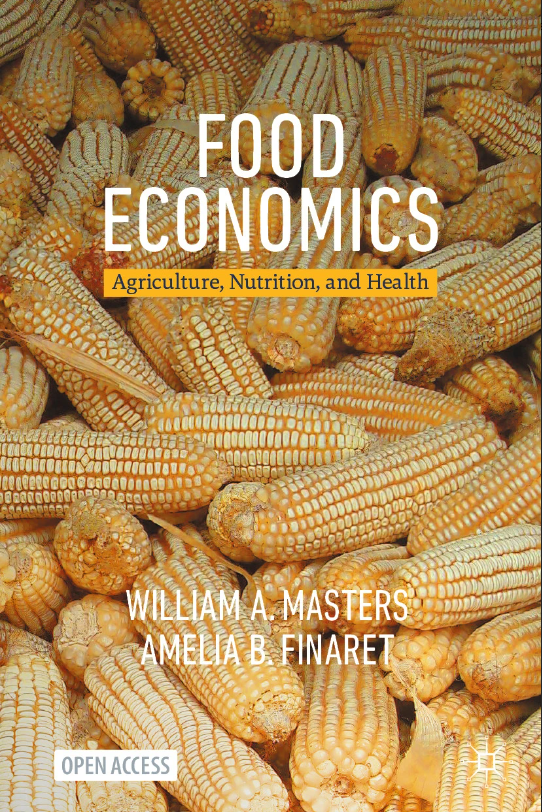A note about the Food Economics book’s cover photo
I really like our cover photo, and want to tell you why — so here’s some text I shared with the Tufts students this semester.

First it’s a photo I took myself, with an old-fashioned camera way back in 2011 during a site visit in Uganda. The farmer was very proud of her crop, and of the granary where she was storing these cobs. The reason I took the picture was just to be polite, and show her that I agreed it was a remarkable harvest worth documenting in a photograph.
Only later did the photo seem beautiful to me — and when thinking about a cover for this book, I realized how it provides a concrete example of global agriculture in action, though the lens of my own experience.
Corn was first domesticated and used across the diverse climatic and moisture regimes of Central and North America, including especially in New England where I grew up. The crop then spread across Africa and Asia with the earliest ocean crossings in the 17th and 18th century.
Corn is interesting because of its variability, as the species turned out to have enormous potential for breeding to create distinct varieties suitable for different purposes in each place. This is somewhat like how dogs and horses were domesticated and became popular in part because people could breed them for different traits, each adapted for diverse uses. One feature of corn’s genetic variation and plasticity is to target different culinary attributes such as color, texture, and taste, but also different heights and leaf configurations as well as heat tolerance, pest resistance etc.
In the U.S. today corn is primarily used as feed for livestock especially poultry, pigs, beef cattle and dairy cows, and to make ethanol as biofuel for cars and trucks. Corn is also crushed to extract cooking oil and starch for industrial uses, and to make liquid sugar for soft drinks and packaged foods. For those large-volume uses, corn breeding is focused almost entirely on photosynthetic efficiency, using each square foot of land for maximum energy from macronutrients (carbs, protein and fats). Surprisingly that’s achieved not by higher yield per plant but by more plants per acre, and since the 1990s through reduced tillage and biological innovations that take best advantage of corn-soy rotation and other techniques. Some industrial corn breeding also focuses on specific amino acids for protein quality, or types of lipids for fat quality, but in the midwestern corn belt across the central U.S. the key focus is just higher yield of energy per acre, and even without irrigation yields have continued to rise steadily for almost a century thanks to thousands of distinct new varieties each of which is planted where it works best and quickly replaced by a better variety.
Meanwhile farmers in Africa have only just begun that process of yield increase, with very few new varieties such as the cobs shown in this photograph. Throughout Uganda and elsewhere in Africa corn is mostly eaten in the form of porridge, sometimes lightly fermented as a food or beverage. Increasingly corn is also fed to chickens for eggs, and to dairy cows for milk, but most people are have such low incomes that they can afford only small quantities of any animal source foods and therefore most corn is eaten by people.
Corn’s agronomic diversity and potential for yield improvement is matched by its culinary versatility. Corn is used in many dishes with enormous cultural significance in the U.S. as fresh sweet corn in the my home area of the northeast, cornbread and grits from the southern U.S., and of course tortillas and tamales and every kind of nacho or corn chip. In other words, this single image nicely captures the most important single crop in the world food system, of particular importance for people from the Americas and Africa.
Plenty of other people also recognize the importance of corn in the food system. Michael Pollan’s famous 2006 book The Omnivore’s Dilemma popularized the way that corn underlies most foods consumed in the U.S., and the third edition of Parke Wilde’s wonderful book on U.S. Food Policy also has corn on its cover. For the second edition of this book, maybe we’ll use a photo of soybeans to emphasize the culinary history of tofu, tempeh, edamame and so forth from East Asia, followed by 20th century industrialization of the crop for protein and oil in the Americas, and its 21st century as tropical soybeans around the world. Or maybe we’ll do a mozaic of the many different crops, animal species, and types of food used to meet all our diverse needs. Any suggestions welcome!
